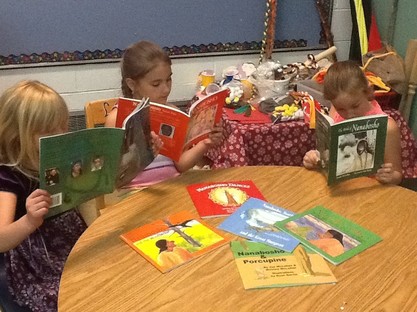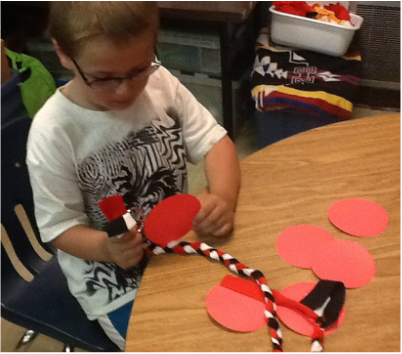STORY STONES INSPIRE CREATIVITY
AND ENRICH ORAL STORYTELLING
Grades 1, 2, and 3, Buchanan school
Submitted by Renee McGurry, Laura Warrenchuk and Linda Stuart
|
Students in grades 1-3 at Buchanan School learned about Aboriginal oral storytelling.
This involved spending time with a variety of Aboriginal storytellers, as a large group and then in smaller, classroom groups. Storytelling visitors to the school included Renée McGurry (St. James Assiniboia Indigenous Educator), Edgar Desjarlais (author of the book titled The Tobanz) and Cory Campbell (story teller, cultural advisor). We were able to connect via video with Cree story teller, Tasha Spillett, and heard the story “Why the moose lives alone in the swamp.” Joe McLellan (author of the Nanabosho series of books) sent us a collection of his books. From all of these story tellers, students learned about the components of legends and their purpose and place in First Nations communities throughout history. |
|
The goal of storytelling was to have students listen to stories and retell their own unique story that contained a moral or a lesson with appropriate behaviors or actions.
Volunteers in the community helped in the preparation of felt, leather, paint and materials for this hands on project. The first step in students story telling was the creation of personal stories on story vines. Children learned how to braid and create their personal story on picture discs that they sequenced on their vine to assist with the retelling of their story. Secondly, students worked with an Aboriginal visual artist and designed their own symbols to depict the characters in their legends. Working individually, students created storyboards using visual images, which they painted onto their rocks. In addition to creating and designing rock designs, students decorated their story bags with art. Students used their decorated rocks to retell stories to their peers, families and in cross-grade groups. |
|
Throughout this project students learned First Nations oral-stories, sequencing, and the retelling of oral stories. More specifically from the art curriculum, students gained a deeper understanding of: Art Language and Tools, Creative Expression in Visual Arts and their Artistic Experience. This project integrated Art, Language Arts, History and Aboriginal Perspectives in an interesting and engaging way, which connected creativity to literacy and built a strong sense of community.
We were fortunate to have an Aboriginal artist working in the St. James Assiniboia School Division (Victoria McIntosh, Indigenous Liaison) provide cultural lessons to accompany her art on the rocks in the outdoor classroom. Now all of the students and community can appreciate and share the creation story as depicted on the rocks.
|
WE ARE ALL TREATY PEOPLE
ROBERT SMITH SCHOOL
|
Submitted by Mel Scott and Cathy Holmes
The genesis for this project began with a 3 day conference entitled, “We Are All Treaty People”. Several teachers from the Lord Selkirk School Division attended and the experience was transformative. We walked away with a greater understanding of how all Canadians are in fact Treaty Partners. We left behind our misconceptions on the relevance of treaties today and the role they will play in Canada’s future.
It is a whole-school mosaic, where each child has expressed his/her understanding of the treaties that bind us together. |
We are an elementary school in Selkirk Manitoba. Approximately 85% of our population is aboriginal, 80% live below the poverty level and 76% are from single parent families. Our goal with this project was to focus on a deeper level of engagement on what it means to be a “treaty people”. We centered our conversations among staff and students on how we understand, respect and honor one another. The culmination of our understanding of how we are united through our treaties is the instillation of our “We Are All Treaty People” in our main hall art gallery. It is a whole school mosaic, where each child has expressed his/her understanding of the treaties that bind us together. It is a visual statement on our commitment to hold onto one another “as long as the sun shines, the grass grows and river flows.” It is now the dynamic center of our school building.
We began our project in February of 2015. As teachers explored the idea of how we are in relationships with one another, and the land, it became obvious that our younger students were viewing this through the lens of the natural environment. To support their ideas we filled the classrooms and hallways with visuals of Canada, the outdoors, animals, weather, landforms, etc. We created backboards that were framed in aboriginal colours and symbols. We took classes into the hallways to talk about the roles that eagles, bears, turtles, wolves, owls, etc. play in aboriginal culture. As time unfolded it was interesting to see the different ways our students interpreted and held onto the information they were processing. Our younger students clung to the scenery of familiar places and animals while older students experimented with mixing symbolism, resources, idealogy and environmental icons into their designs.
We began our project in February of 2015. As teachers explored the idea of how we are in relationships with one another, and the land, it became obvious that our younger students were viewing this through the lens of the natural environment. To support their ideas we filled the classrooms and hallways with visuals of Canada, the outdoors, animals, weather, landforms, etc. We created backboards that were framed in aboriginal colours and symbols. We took classes into the hallways to talk about the roles that eagles, bears, turtles, wolves, owls, etc. play in aboriginal culture. As time unfolded it was interesting to see the different ways our students interpreted and held onto the information they were processing. Our younger students clung to the scenery of familiar places and animals while older students experimented with mixing symbolism, resources, idealogy and environmental icons into their designs.
It is a visual statement on our commitment to hold onto one another as long as the sun shines, the grass grows and the river flows. Our next phase was preparing to face the canvasses. Students were given sheets of paper to explore what, where and how they were going to create their paintings. For some students this was a useful first step strategy while others needed to go straight to their paintings. Prior to tipping brush into paint we had whole group pre-teaching on color mixing, choosing brushes, diluting paint, cleaning brushes, backgrounds, foregrounds, and working with mistakes. During the painting sessions we discovered artists among our students, talented colour mixers, critics, coaches and idea experts. It was inspiring to witness how many students turned to the experts in the room for help and how many experts put down their brushes to inspire or support a friend. All the moments in this mosaic were transformative for the teachers involved.
Each class was scheduled for two one hour sessions in the paint room. All students were able to extend their times until they felt their mosaic was complete. June was approaching and we started experimenting with how to assemble and place each piece in the mosaic whole. But then it began to rain. And the roof began to leak. And the ceiling panels grew soggy and began to drop papier mache pieces on the floor. Our leaky roof went from chronic to fatal and plans were made to replace the entire school roof. We anticipated the job would be complete by September. The last nail was pounded into place on Nov.19, 2015. This has been an exciting, transformative experience. |
In the second week of November we unpacked all the canvasses on the stage floor in the gym. We invited the Art Club students to gather on the stage during the lunch hour break to picnic with the pictures and then arrange them as they thought would look the best in the gallery. Their enthusiasm and thoughtfulness during this time was obvious. You could see children debating the compatibility of color, form and content with great deliberation and hard won consensus. The results were stunning!
On November 27, 2015 our gallery was opened to the public. Eager students stood with moms and dads, grannies and aunties looking to find their piece of the mosaic. We have already extended the gallery to include a ceramic tile installation that was undertaken with an artist in the School. We are purchasing several large frames that will be placed opposite “We Are All Treaty People” and offer other mediums and designs.
This has been an exciting, transformative experience. Using art as the window into our thinking we have cross connected our vision to include history, mathematics, reading, and aboriginal culture. We have learned the power of visual representation to communicate our ideas, extend our reach and engage our community.
On November 27, 2015 our gallery was opened to the public. Eager students stood with moms and dads, grannies and aunties looking to find their piece of the mosaic. We have already extended the gallery to include a ceramic tile installation that was undertaken with an artist in the School. We are purchasing several large frames that will be placed opposite “We Are All Treaty People” and offer other mediums and designs.
This has been an exciting, transformative experience. Using art as the window into our thinking we have cross connected our vision to include history, mathematics, reading, and aboriginal culture. We have learned the power of visual representation to communicate our ideas, extend our reach and engage our community.








